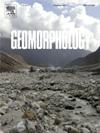Knickpoint migration and transient landscapes on the continental margin of Northeastern Brazil
IF 3.1
2区 地球科学
Q2 GEOGRAPHY, PHYSICAL
引用次数: 0
Abstract
The response of bedrock rivers to a sudden drop in base level is the widespread formation and upstream propagation of knickpoints. This process progresses to restore steady-state conditions. The timeframe between the onset and end of the disturbance is known as the transient state. In this study, we identify and discuss the distribution pattern, timing, and potential controls of knickpoints in the eastern seaboard of Northeast Brazil. We focused on the Capiá River basin, one of the largest tributaries of the lower São Francisco River. We carried out topographic analysis based on digital elevation models, field observations, numerical modeling of knickpoint retreat, and base-level fall rates using a linear inverse model. Using these techniques, we identified the imprint of the last regional base-level fall event in the São Francisco River, corresponding to the formation and the opening of its canyon. We estimated that the incision was at least 100 m deep. The knickpoints are of the slope-break type and exhibit a systematic spatial distribution pattern. They separate an upstream relict landscape with low relief from a downstream, high-relief sector initiated by the base level lowering. All knickpoints occur near the confluence of trunk streams at similar elevations, resulting in a clustered chi-profile pattern. Inferred total knickpoint recession is strongly dependent on the drainage area. Additionally, the numerical model indicates that the knickpoints are mobile and genetically related, and that the incision wave initiated sometime within the 106 to 107 years BP interval, with the best fit at or after 1.5 Ma BP, corresponding to a retreat velocity of 0.01 m/yr. These results are independently supported by the linear inversion model constrained by erosion rates from previous studies. Lastly, we hypothesize that the interplay between climate (i.e., erosion threshold), epeirogenic uplift, and Late Cenozoic tectonic adjustments is responsible for the transient state of the study area.
求助全文
约1分钟内获得全文
求助全文
来源期刊

Geomorphology
地学-地球科学综合
CiteScore
8.00
自引率
10.30%
发文量
309
审稿时长
3.4 months
期刊介绍:
Our journal''s scope includes geomorphic themes of: tectonics and regional structure; glacial processes and landforms; fluvial sequences, Quaternary environmental change and dating; fluvial processes and landforms; mass movement, slopes and periglacial processes; hillslopes and soil erosion; weathering, karst and soils; aeolian processes and landforms, coastal dunes and arid environments; coastal and marine processes, estuaries and lakes; modelling, theoretical and quantitative geomorphology; DEM, GIS and remote sensing methods and applications; hazards, applied and planetary geomorphology; and volcanics.
 求助内容:
求助内容: 应助结果提醒方式:
应助结果提醒方式:


